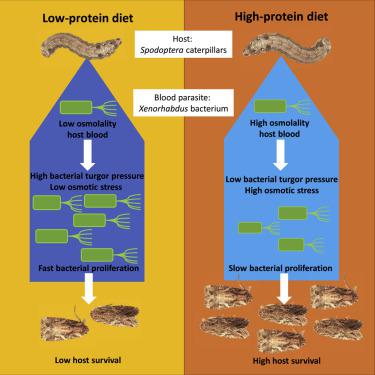Current Biology ( IF 8.1 ) Pub Date : 2020-06-04 , DOI: 10.1016/j.cub.2020.04.058 Kenneth Wilson 1 , Robert Holdbrook 1 , Catherine E Reavey 1 , Joanna L Randall 1 , Yamini Tummala 1 , Fleur Ponton 2 , Stephen J Simpson 3 , Judith A Smith 4 , Sheena C Cotter 5

|
Recent research has suggested that the outcome of host-parasite interactions is dependent on the diet of the host, but most previous studies have focused on “top-down” mechanisms, i.e., how the host’s diet improves the host immune response to drive down the parasite population and improve host fitness. In contrast, the direct impacts of host nutrition on parasite fitness and the mechanisms underpinning these effects are relatively unexplored. Here, using a model host-pathogen system (Spodoptera littoralis caterpillars and Xenorhabdus nematophila, an extracellular bacterial blood parasite), we explore the effects of host dietary macronutrient balance on pathogen growth rates both in vivo and in vitro, allowing us to compare pathogen growth rates both in the presence and absence of the host immune response. In vivo, high dietary protein resulted in lower rates of bacterial establishment, slower bacterial growth, higher host survival, and slower speed of host death; in contrast, the energy content and amount of carbohydrate in the diet explained little variation in any measure of pathogen or host fitness. In vitro, we show that these effects are largely driven by the impact of host dietary protein on host hemolymph (blood) osmolality (i.e., its concentration of solutes), with bacterial growth being slower in protein-rich, high-osmolality hemolymphs, highlighting a novel “bottom-up” mechanism by which host diet can impact both pathogen and host fitness.
中文翻译:

渗透压作为一种新机制解释饮食对血液寄生虫感染结果的影响。
最近的研究表明,宿主-寄生虫相互作用的结果取决于宿主的饮食,但以前的大多数研究都集中在“自上而下”的机制上,即宿主的饮食如何提高宿主的免疫反应以降低宿主的免疫反应。寄生虫种群和改善宿主健康。相比之下,宿主营养对寄生虫健康的直接影响以及支持这些影响的机制相对尚未探索。在这里,我们使用模型宿主 - 病原体系统(Spodoptera littoralis毛虫和Xenorhabdus nematophila,一种细胞外细菌血液寄生虫),探索宿主膳食常量营养素平衡对体内和体外病原体生长率的影响,使我们能够比较存在和不存在宿主免疫反应的病原体生长率。在体内,高膳食蛋白质导致较低的细菌建立率、较慢的细菌生长、较高的宿主存活率和较慢的宿主死亡速度;相比之下,饮食中的能量含量和碳水化合物含量解释了病原体或宿主健康的任何衡量标准的变化很小。在体外,我们表明这些影响在很大程度上是由宿主膳食蛋白质对宿主血淋巴(血液)渗透压(即其溶质浓度)的影响驱动的,在富含蛋白质的高渗透压血淋巴中细菌生长较慢,突出显示一种新的“自下而上”的机制,宿主饮食可以通过这种机制影响病原体和宿主的健康。











































 京公网安备 11010802027423号
京公网安备 11010802027423号